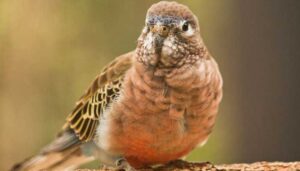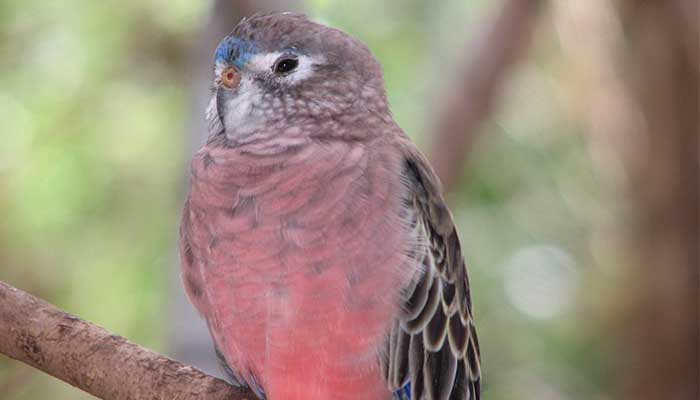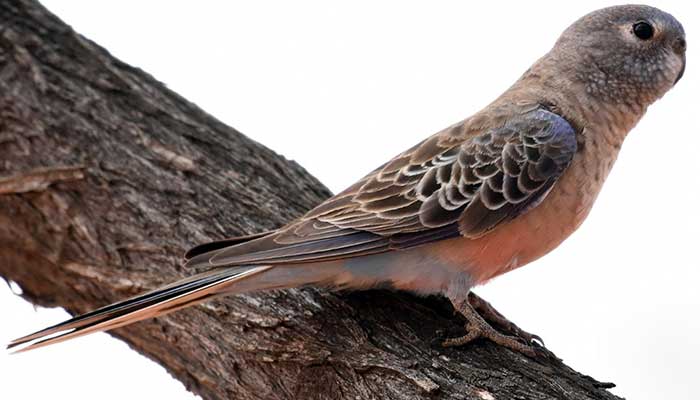
Bourke’s Parrott is a good option for people who are new to parrots and intend to keep them; This bird has calm behavior and they can entertain themselves. They are largely quiet, making them a good choice for single or small cages as well as being ideal for apartment dwellers. They can be good friends for finches or cockatiel. Of course, this also means that you need to keep the Bourke’s Parrott away from larger and more aggressive birds.
How to take care of Bourke’s Parrott?
It is true that Borks has a calm nature, but he loves to fly very much, so you should take him out of the cage for at least one to two hours a day. Do not choose a small cage. At least your cage should be 6 feet long and high enough to place some tree branches, and play equipment such as tops and ladders.
Bourke’s Parrott profile
Body length – 19 cm
Body weight – 45 grams
The life span of 15 years
From the order of parrots
dark parrot
Scientific name – Neopsephotus bourkii
other posts:
- Maintenance and breeding of canaries
- Make money from raising Cockatiel
- How to gray parrot talking?
- African gray parrot or Casco parrot
- Disadvantages of keeping dogs at home
History and ancestors of the Bourke’s Parrott
The Bourke’s Parrott is a species native to Australia. Their habitat spans most of the continent, including Queensland, New South Wales, Central, South, and Western Australia. The main habitat of this species is dry plains, but they also live in areas with native cypress trees and eucalyptus. Wild Bourke’s Parrotts also live in urban areas. These birds owe their name to Sir Richard Burke, the governor of New South Wales, Australia; A person who ruled this area from 1831 to 1837. Scientifically, the species itself was classified as a part of the genus Neofama (grass parrots), but since the 1990s, it has been classified as the genus Neopsphotus. Successful breeding programs have made the Bourke’s Parrott a popular pet in homes around the world. It is necessary to mention that this species is not in danger of extinction and the population of wild birds of this species is increasing.

Temperament of the Bourke’s Parrott
As a loving, docile, and good-natured species, the Bourke’s Parrott is a good choice for a pet. Especially if they are fed by human hands from childhood, their relationship with the owner and the one who takes care of them will be very deep. They are very intelligent birds and at the same time, compared to other parrots, they have a very gentle and quiet behavior. Bourke’s Parrotts are cuddly and prefer human companionship. You should always expect them to sit on your shoulder. They also sometimes enjoy flying around with a lot of energy.
Bourke’s Parrott speech and vocalization
The peak of their activity is usually evident right after sunrise and sunset; A time when they may be a little noisy but without harassment. In general, Borks parrot is a calm bird compared to other parrots and unlike others, it is not talkative or mischievous and playful.
The appearance of Bourke’s Parrott
Although they are not very bright and full of different colors compared to other species, Bourke’s Parrotts are still eye-catching and beautiful. They have dusty brown ornamental feathers that cover the breast and belly in combination with pink feathers. The tail feathers are also blue. The backs of the Bourke’s Parrotts are a darker gray-brown, with each feather highlighted with a lighter color towards the margin. The differences between the two sexes of the bird can also be identified with the eyes. Adult males have a blue forehead, while females have either no blue forehead at all or a very small one. Males also appear somewhat larger than females and are larger in size. Of course, some color mutations are evident and possible in this species. One of the most popular types is rose-colored borax, which has an attractive light pink shade on its body.
Caring for a Bourke’s Parrott
These birds have a great desire to fly and therefore it is better to keep them in large cages with enough space to fly instead of small cages. A suitable cage should be at least 6 feet long and have at least a few tree branches for the bird to climb. If you cannot provide them with a large standing cage, it is better to choose at least the largest cage that you have available and it is possible to install it at home. Because these birds like to fly horizontally, it is better to consider the width of the cage rather than its height. A suitable cage for them should be at least 3 feet long and 5.5 feet wide and high. A Bourke’s Parrott has no problem being kept next to another borax. If you keep him alone, you need to interact with him every day so that he does not get overwhelmed by loneliness. Swings are a great addition to the cage. These birds are also very fond of bathing so make sure they have a bathing basin inside their cage. The water provided for bathing must be fresh and clean. You can also provide a pleasant atmosphere for his activity with a lukewarm water spray. Parrots are highly social birds by nature, and Burkes are no exception. Although they require less attention than some other species, your bird still needs at least two hours of attention, interaction and training per day.

Common problems in the health and health of Bourke’s Parrott
Like other species of parrots, the borax can be susceptible to psittacosis. This disease can spread among birds and humans. The bacterial disease psittacosis will lead to respiratory problems, but it can be easily treated with antibiotics. A number of other viruses can also attack the bird’s health, leading to feather problems, diarrhea or pneumonia. Parrots are also prone to sinus congestion caused by Aspergillus. Proper nutrition and hygiene prevent such problems from occurring. Some parasites can also threaten the health of parrots. Intestinal parasites may lead to emaciation and depression of the bird, while external mites and lice damage the feathers and cause them to fall.
Diet and nutrition
Bourke’s Parrotts are herbivorous parrots and they search between fields and plains to find food. The wild Bourke’s Parrott has a diet based on seeds, grasses and a variety of plants including fruits, berries as well as insects. He also consumes other types of food provided they are available. However, a pet borax needs a balanced diet. Young birds eat up to one tablespoon of small seed mix along with a variety of fresh vegetables and fruits.
Training and training Bourke’s Parrott
Bourke’s Parrotts are less active than other parrots, but they still need 2-3 hours of play time outside the cage; Of course, their playing environment should be supervised. They like to fly along the horizon, and therefore you should be more sensitive about the security of their flight environment; The environment should be clear of other animals, ceiling fans, and open doors and windows. Your borax will enjoy having toys. Provide them with common plastic toys with bright colors and attractive bells, along with some everyday items such as egg combs for chewing and tearing.
Comments